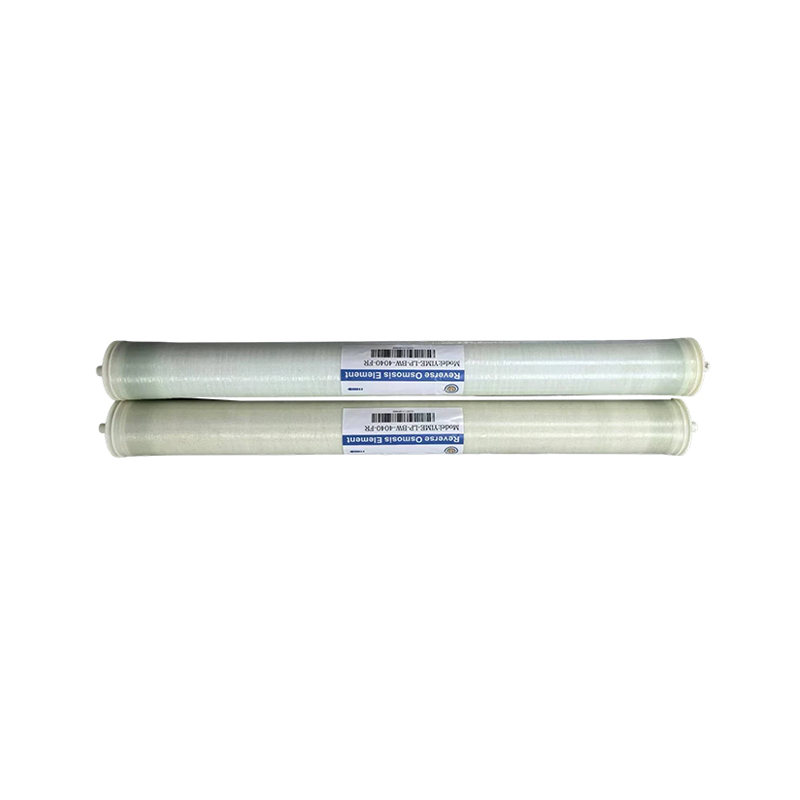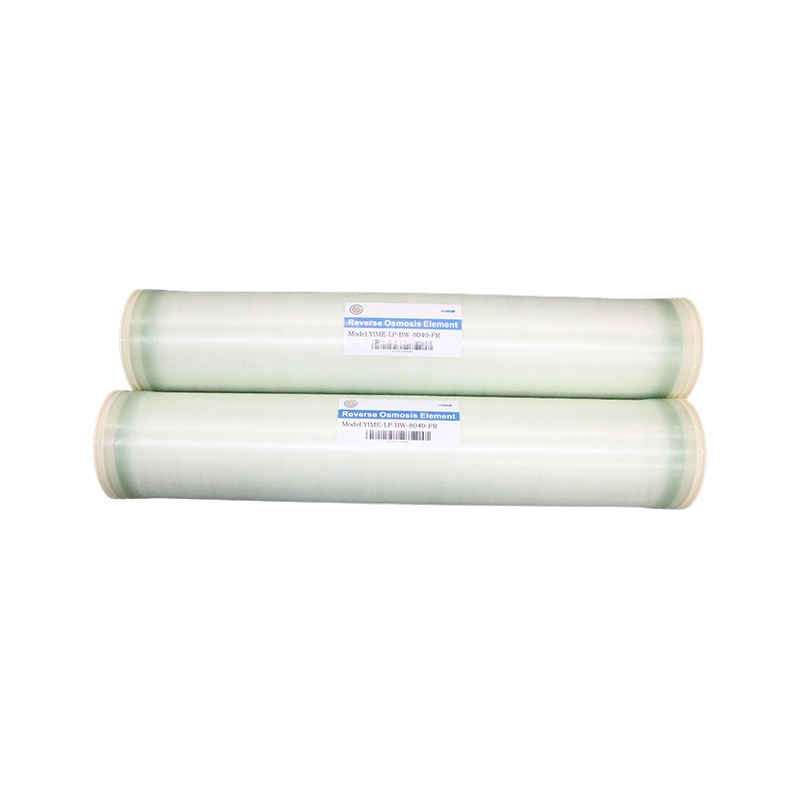How to restore the performance of contaminated reverse osmosis RO membrane by improving the cleaning procedure?
Release Time : 2025-04-05
Improving the cleaning procedure to restore the performance of contaminated reverse osmosis (RO) membrane is a key step to ensure the long-term and efficient operation of the water treatment system. Over time, reverse osomosis RO membranes will inevitably be affected by various contaminants, such as inorganic salt scale, organic matter deposition, and microbial growth, which will lead to a decrease in membrane flux and desalination efficiency. By scientifically and rationally designing the cleaning process and selecting appropriate cleaning agents, contaminants can be effectively removed, and the performance of the membrane can be restored or even improved.
First of all, accurate diagnosis of the type of contamination is crucial to developing an effective cleaning plan. Different types of contaminants require different cleaning strategies. For example, inorganic salt scale formed by hardness ions such as calcium and magnesium can usually be dissolved by acid washing; while rust or oxides may require stronger reducing agents or chelating agents. For organic contamination, alkaline cleaning agents can destroy the organic molecular structure, making it easier to rinse off. If there is biological contamination, disinfection with a cleaning solution containing bactericidal ingredients is required. Therefore, before starting the cleaning, analyzing the contaminants on the membrane surface can help determine the most suitable cleaning method.
Selecting the right cleaning agent is also an important part of restoring the performance of reverse osmosis ro membrane. The ideal cleaning agent should not only be able to effectively remove specific types of contaminants, but also minimize damage to the membrane material itself. In actual operation, it is often necessary to adjust the type and concentration of the cleaning agent according to the specific situation. For example, citric acid is often used to remove common scales such as calcium carbonate due to its mild and efficient descaling ability; while for organic contaminants that are difficult to remove, surfactants such as sodium dodecyl sulfate (SDS) show good cleaning effects. It is worth noting that excessive concentrations of chemical agents may corrode the membrane surface or cause other adverse reactions, so the cleaning solution must be prepared strictly in accordance with the manufacturer's recommended ratio.
Temperature control is also an important factor affecting the cleaning effect. Properly increasing the temperature of the cleaning solution helps to accelerate the chemical reaction rate, thereby enhancing the effect of the cleaning agent. However, too high a temperature may also cause accelerated aging of the membrane material or irreversible damage. Generally speaking, the optimal cleaning temperature range for most commercial reverse osomosis ro membranes is between 30°C and 40°C, but the specific values should be referred to the guidance in the product manual. In addition, maintaining a constant temperature throughout the cleaning process also helps to ensure the consistency and effectiveness of the cleaning.
In addition to choosing the right cleaning agent and controlling the temperature, the flow rate and pressure management during the cleaning process should not be ignored. Higher flow rates help increase the degree of turbulence, allowing the cleaning liquid to contact the membrane surface more fully, thereby more effectively stripping off the attached pollutants. However, too high a flow rate may cause greater shear forces inside the membrane assembly, causing mechanical damage. Therefore, it is very important to find a flow rate balance point that can ensure good cleaning results without causing additional damage to the membrane. Similarly, the pressure during cleaning should also be moderate to avoid the negative effects of excessive pressure.
Finally, establishing a regular maintenance and cleaning plan is one of the effective measures to prevent reverse osomosis ro membrane contamination. By setting a reasonable cleaning cycle, timely action can be taken at the early stage of contamination to prevent the problem from worsening. At the same time, recording the changes in key parameters before and after each cleaning, such as water production, desalination rate and pressure difference, can not only evaluate the cleaning effect, but also provide a basis for future optimization. In addition, training operators to master the correct cleaning techniques and precautions to ensure that each cleaning is strictly carried out according to established standards is crucial to maintaining the stable operation of the RO system.
In short, the performance of the contaminated reverse osomosis ro membrane can be significantly improved by accurately identifying the type of contamination, selecting the appropriate cleaning agent, reasonably controlling the temperature, flow rate and pressure, and implementing a scientific maintenance strategy. This not only helps to extend the service life of the membrane and reduce operating costs, but also ensures the continued efficient operation of the water treatment system to meet increasingly stringent environmental protection requirements and market demands. With the advancement of technology, more innovative cleaning technologies and methods are expected to be developed in the future to further improve the cleaning efficiency and durability of reverse osomosis ro membrane.
First of all, accurate diagnosis of the type of contamination is crucial to developing an effective cleaning plan. Different types of contaminants require different cleaning strategies. For example, inorganic salt scale formed by hardness ions such as calcium and magnesium can usually be dissolved by acid washing; while rust or oxides may require stronger reducing agents or chelating agents. For organic contamination, alkaline cleaning agents can destroy the organic molecular structure, making it easier to rinse off. If there is biological contamination, disinfection with a cleaning solution containing bactericidal ingredients is required. Therefore, before starting the cleaning, analyzing the contaminants on the membrane surface can help determine the most suitable cleaning method.
Selecting the right cleaning agent is also an important part of restoring the performance of reverse osmosis ro membrane. The ideal cleaning agent should not only be able to effectively remove specific types of contaminants, but also minimize damage to the membrane material itself. In actual operation, it is often necessary to adjust the type and concentration of the cleaning agent according to the specific situation. For example, citric acid is often used to remove common scales such as calcium carbonate due to its mild and efficient descaling ability; while for organic contaminants that are difficult to remove, surfactants such as sodium dodecyl sulfate (SDS) show good cleaning effects. It is worth noting that excessive concentrations of chemical agents may corrode the membrane surface or cause other adverse reactions, so the cleaning solution must be prepared strictly in accordance with the manufacturer's recommended ratio.
Temperature control is also an important factor affecting the cleaning effect. Properly increasing the temperature of the cleaning solution helps to accelerate the chemical reaction rate, thereby enhancing the effect of the cleaning agent. However, too high a temperature may also cause accelerated aging of the membrane material or irreversible damage. Generally speaking, the optimal cleaning temperature range for most commercial reverse osomosis ro membranes is between 30°C and 40°C, but the specific values should be referred to the guidance in the product manual. In addition, maintaining a constant temperature throughout the cleaning process also helps to ensure the consistency and effectiveness of the cleaning.
In addition to choosing the right cleaning agent and controlling the temperature, the flow rate and pressure management during the cleaning process should not be ignored. Higher flow rates help increase the degree of turbulence, allowing the cleaning liquid to contact the membrane surface more fully, thereby more effectively stripping off the attached pollutants. However, too high a flow rate may cause greater shear forces inside the membrane assembly, causing mechanical damage. Therefore, it is very important to find a flow rate balance point that can ensure good cleaning results without causing additional damage to the membrane. Similarly, the pressure during cleaning should also be moderate to avoid the negative effects of excessive pressure.
Finally, establishing a regular maintenance and cleaning plan is one of the effective measures to prevent reverse osomosis ro membrane contamination. By setting a reasonable cleaning cycle, timely action can be taken at the early stage of contamination to prevent the problem from worsening. At the same time, recording the changes in key parameters before and after each cleaning, such as water production, desalination rate and pressure difference, can not only evaluate the cleaning effect, but also provide a basis for future optimization. In addition, training operators to master the correct cleaning techniques and precautions to ensure that each cleaning is strictly carried out according to established standards is crucial to maintaining the stable operation of the RO system.
In short, the performance of the contaminated reverse osomosis ro membrane can be significantly improved by accurately identifying the type of contamination, selecting the appropriate cleaning agent, reasonably controlling the temperature, flow rate and pressure, and implementing a scientific maintenance strategy. This not only helps to extend the service life of the membrane and reduce operating costs, but also ensures the continued efficient operation of the water treatment system to meet increasingly stringent environmental protection requirements and market demands. With the advancement of technology, more innovative cleaning technologies and methods are expected to be developed in the future to further improve the cleaning efficiency and durability of reverse osomosis ro membrane.







